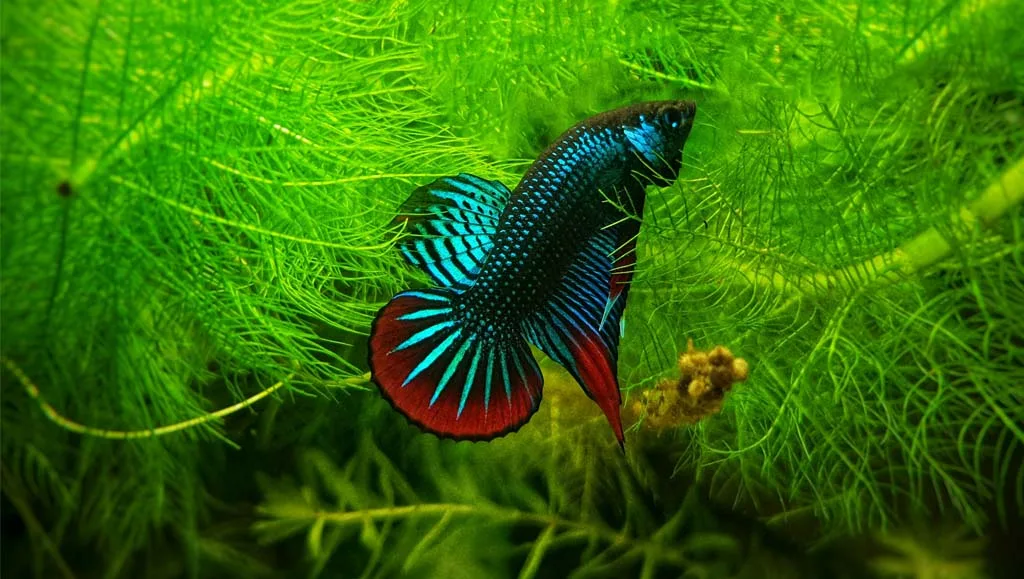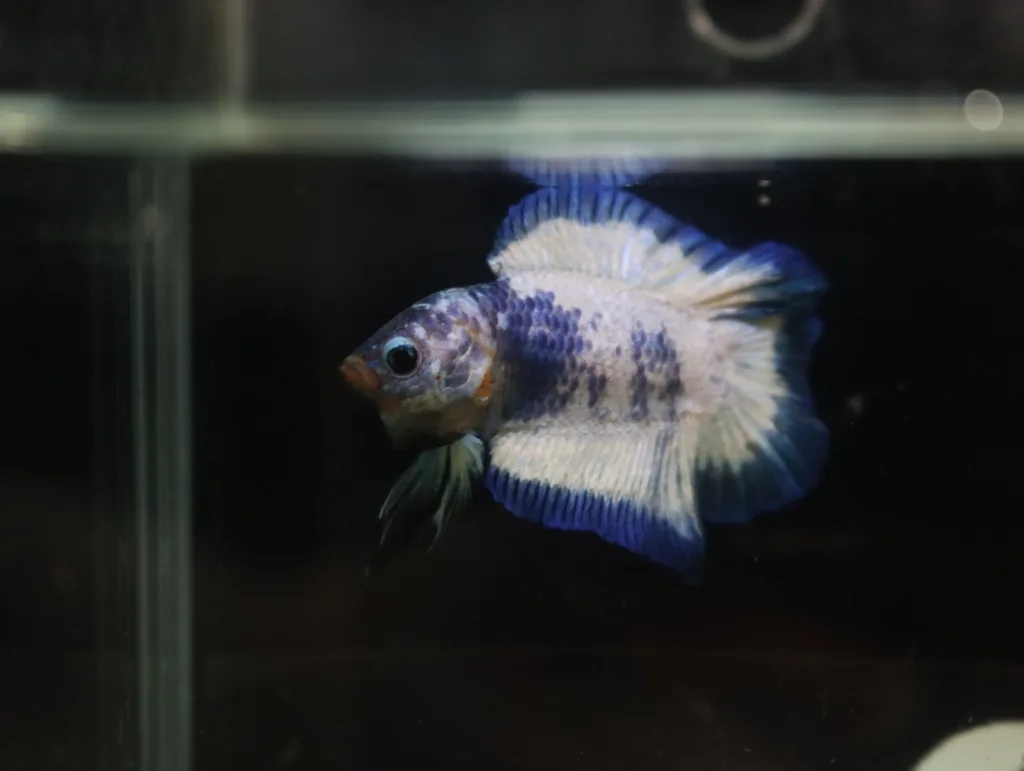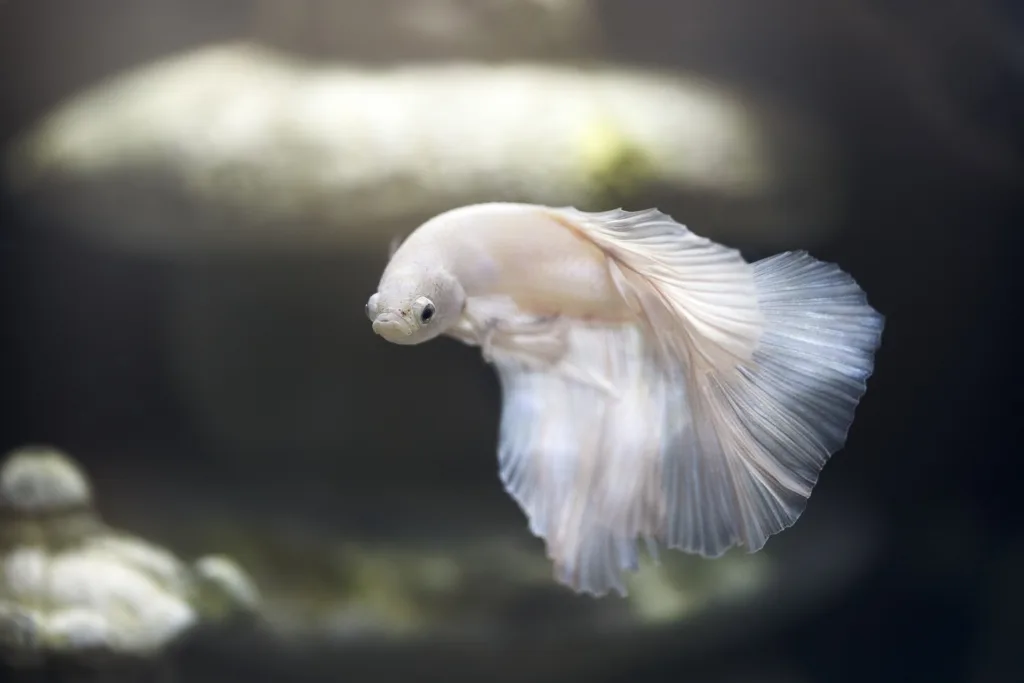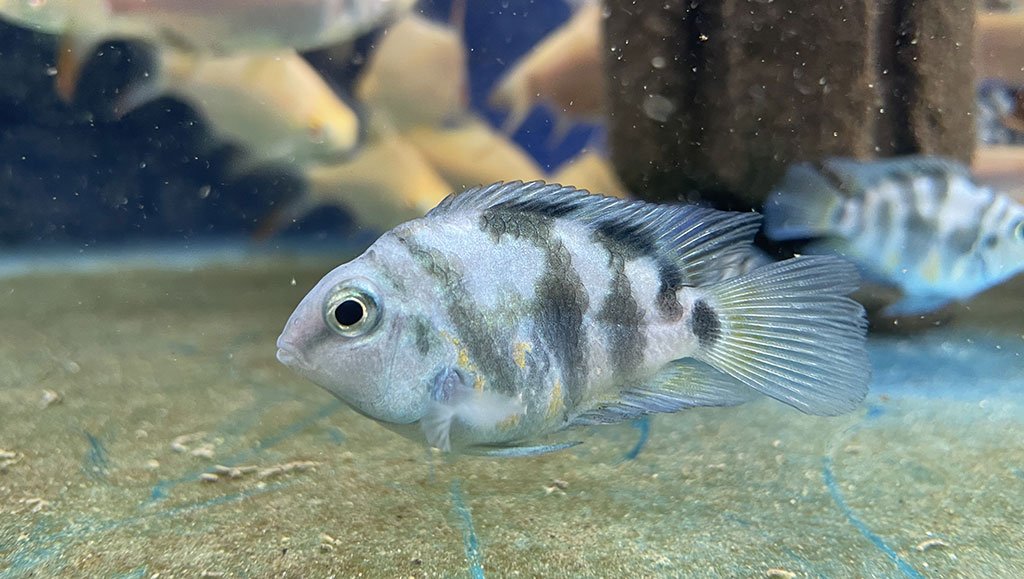If you’re seeing your betta fish fins turning white, it’s not a moment for panic—it’s a call to action!
Your beautiful Siamese fighter might be silently signaling distress, and as an aquarist cum betta aficionado, it’s your duty to understand and tackle the issue with the precision of a scuba diver in deep waters.
Here’s how to investigate, address, and, most importantly, prevent the mystery of the whitening fins from affecting your aquatic friend.
Possible Causes of Betta Fish Fins Turning White
Fungal Infections
Ah, the murky waters of fungal infections – a common adversary for our betta buddies. These infections manifest as a white, cottony growth on the fins, making them look eerily frost-touched. But fear not! Recognizing this early can lead to swift, effective treatment.
Bacterial Infections
Bacterial infections are the silent ninjas of the aquarium, often sneaking up unnoticed until they’ve made their mark. These infections can cause the fins to appear white or milky and may attack the body too, causing ulcers. Knowing the enemy is half the battle won, and in this case, it’s all about keeping an eye out for these stealthy invaders.
Parasitic Infestations
Tiny but mighty, parasites like Ich (Ichthyophthirius multifiliis) can cause severe distress, producing a peppering of white spots across the majestic fins of your betta. It’s like a constellation gone wrong on their delicate fins and bodies, but with the right treatment, the stars can align once again in their favor.
Fin Rot
Fin Rot is akin to the dark villain in our tale, potentially turning the majestic fins of your betta white and frayed, as if caught in a thorny underbrush. This condition, often bacterial or fungal, thrives in poor water conditions, making vigilance and cleanliness your shining armor.
Environmental Stressors
Just like us, our aquatic friends feel the strain of their surroundings. Abrupt changes in water temperature, pH swings, and toxic levels of ammonia or nitrites can cause stress, leading to a compromised immune system and, eventually, those worrying white fins. Serenity and stability in their tank environment are keys to their well-being.
Nutritional Deficiencies
A balanced diet is crucial for keeping the vibrant colors and health of your betta’s fins. Lack of essential nutrients can lead to a lackluster appearance and white discoloration. Think of it as ensuring your betta has a plate full of rainbow-colored food, metaphorically speaking.
If you’ve noticed your Betta fish’s fins turning white, it could indicate a potential health concern that requires attention. While addressing this issue, it’s also crucial to understand the broader aspects of Betta fish care, including their dietary needs.
One critical aspect to consider is “How Long Can A Betta Fish Live Without Food?” Understanding this can help you gauge the urgency of addressing any health issues your Betta may be experiencing and ensure you’re providing the best care possible.
Therefore, exploring both topics can contribute to maintaining the overall well-being of your Betta fish.
Poor Water Quality
Perhaps the most preventable yet oft-overlooked villain, poor water quality, is a prime culprit behind many betta ailments, including white fins. Regular water changes, monitoring, and a trusty water testing kit are your best friends in combating this silent threat.
Genetic Conditions
Sometimes, the cause of white fins might be written in the stars—or more accurately, in their genetics. Some bettas have genetic predispositions that cause their fins to lighten with age, a process as natural as the changing of the seasons, requiring understanding and acceptance rather than treatment.
By becoming a detective in your own right, examining these possible causes, you can help ensure your betta lives a long, vibrant, and healthy life. The key is observation, action, and a lot of love for your finned friends.
Signs and Symptoms to Watch For

Knowing what symptoms to keep an eagle eye on can make all the difference in ensuring the health and happiness of your aquatic companion. Here are some key signs and symptoms to monitor:
White Patches or Spots on Fins
Not all that glitters is gold, and not all that’s white is healthy. White patches or spots could be the first sign of trouble, signaling infections or infestations that require your prompt attention.
Changes in Fin Appearance, such as Fraying or Deterioration
Keep a lookout for fins that begin to look ragged or deteriorate – it’s like finding a frayed thread on your favorite sweater. These changes can indicate Fin Rot or environmental stresses taking a toll on your betta’s health.
Behavioral Changes, such as Lethargy or Loss of Appetite
Is your normally lively betta suddenly acting more like a couch potato, showing little interest in food or its surroundings? Such changes in behavior could be your betta waving a flag, signaling it’s time for a health check.
Other Physical Signs of Illness or Discomfort
Other alarming signs might include bloating, unusual swimming patterns, or rubbing against tank objects. It’s their way of saying, “Hey, something’s not right here!”
Clamped Fins
When your betta keeps its fins close to its body, rather than elegantly displaying them, it’s akin to us bundling up when we’re not feeling well. This behavior, known as clamping, is often a sign of discomfort or illness.
Cloudy Eyes
Cloudy or dull eyes in your betta might not be just about a bad day. It could indicate a brewing health issue that needs your keen eye and nurturing care.
By becoming a vigilant guardian for your betta, watching for these signs with the dedication of a knight in shining armor, you’re not just ensuring their survival – you’re ensuring they thrive. Armed with this knowledge, your quest to protect and nurture your betta becomes a fulfilling adventure in aquatic guardianship.
Steps to Take if Your Betta Fish’s Fins Turn White
When you notice the first signs of white fins on your beloved betta, it’s akin to spotting the first cloud on a sunny day. But fear not! Here are the steps to bring back the sunshine and ensure your betta’s fins remain as vibrant and colorful as a clear, blue sky.
Observation and Documentation of Symptoms
Grab your detective hat and start the investigation! Keep a close eye on your betta, noting any changes in behavior, appearance, or appetite. Documenting these observations can provide valuable insights into the progression of symptoms, making it easier to identify the root cause and tailor the treatment accordingly. Think of it as keeping a health diary for your aquatic pal!
Water Quality Assessment and Maintenance
Test the waters, literally! Poor water quality is often the culprit behind health issues in aquarium fish. Regularly check the pH, ammonia, nitrite, and nitrate levels with a reliable water testing kit. Ensure the water is pristine by performing partial water changes weekly, removing about 20-25% of the water and replacing it with fresh, treated water. This step is like hitting the reset button on your betta’s home, ensuring it’s a safe and clean environment.
Quarantine Procedures if Necessary
Should you detect any contagious diseases, setting up a quarantine tank can prevent the spread and give your betta a peaceful place to recover. This temporary home should be equipped with proper filtration, heating, and enough space for your betta to swim comfortably. It’s like providing a cozy, private room for your betta to recuperate in peace.
Treatment Approaches, Including Medication or Aquarium Additives
Depending on the diagnosis, you may need to administer medication or utilize aquarium additives specifically designed to treat fungal, bacterial, or parasitic infections. Always follow the manufacturer’s instructions and consult with a vet specialized in aquatic animals if you’re unsure. This approach is akin to choosing the right medicine for a specific ailment, targeting and eliminating the problem at its root.
Diet and Nutritional Support
Boost your betta’s immune system with a balanced diet rich in essential nutrients. Offer a variety of foods, including high-quality pellets, frozen or live foods such as brine shrimp, and daphnia. Think of it as serving a gourmet meal that not only satisfies the taste buds but also fortifies health.
Stress Reduction Techniques
Create a serene habitat for your betta by adding natural plants, appropriate hiding spots, and ensuring adequate space for exploration. Maintain a consistent water temperature and lighting schedule to mimic a natural environment. Reducing stress is like providing a soothing, zen-like atmosphere that promotes healing and well-being.
By following these steps with enthusiasm, knowledge, and nurturing care, you’ll not only address the immediate issue of whitening fins but also enhance your betta’s overall quality of life. It’s a proactive and loving approach to ensuring your colorful companion swims happily for many years to come!
Diagnosis and Treatment Options
Identifying and treating the underlying causes of your betta’s health issues is a crucial step toward recovery. Here’s how to proceed with love and science by your side:
Veterinary Examination and Diagnosis
When in doubt, consult the experts! A veterinary examination can offer a definitive diagnosis, shedding light on the shadows of uncertainty. Aquatic veterinarians, equipped with their specialized knowledge, can conduct a range of tests to identify the root cause of your betta’s symptoms. They can scrutinize everything from water samples to your fish’s physical health, ensuring that no stone is left unturned.
Treatment Plans Tailored to the Underlying Cause
Once the diagnosis is clear, your vet can craft a treatment plan as unique as your betta’s vibrant colors. Tailored treatment addresses the specific needs of your fish, whether it’s adjusting water parameters, prescribing a specific diet, or dealing with stressors. This bespoke approach ensures your betta receives exactly what it needs to flourish.
Medications for Fungal, Bacterial, or Parasitic Infections
Armed with knowledge and a prescription, treating infections becomes a targeted mission. Whether it’s antifungal, antibacterial, or antiparasitic medications, there’s a solution designed to combat the invaders threatening your betta’s health. Administer these medications with care, following dosages precisely, to banish the unwanted guests without a trace.
Environmental Adjustments to Promote Healing
Healing goes beyond medication – it’s about cultivating an oasis of tranquility. Adjust your betta’s environment to promote recovery. Whether it’s optimizing water conditions, reducing noise and disturbances, or creating hideaways for rest, every adjustment is a step toward a stronger, happier betta.
Ongoing Monitoring and Care
After initial treatments, continuous care is essential. Keep a watchful eye on your betta’s behavior and physical appearance, ready to adjust treatments as needed. Regular check-ins with your vet can ensure any adjustments to the treatment plan are timely and effective. Think of it as accompanying your betta on its health journey – a partnership in wellness.
Preventive Measures to Avoid Future Health Issues
Prevention is better than cure. Once your betta is back to its radiant self, focus on preventive measures to keep it swimming strong. This includes maintaining impeccable water quality, offering a nutritious diet, and creating a stress-free environment. Your vigilant care now lays the foundation for a healthy, vibrant future for your aquatic friend.
Incorporating these diagnoses and treatment options into your betta’s care regimen empowers you to act decisively and lovingly in the face of health challenges. Not only do they offer a beacon of hope during times of distress, but they also enrich your ongoing relationship with your betta, ensuring a bond that is as enduring as it is enriching.
Preventative Measures and Home Care Tips

Preventative care and proper home maintenance are key to ensuring your betta fish thrives in its environment, remaining healthy and vibrant. By adhering to the following guidelines, you’re taking proactive steps to prevent future health issues and potentially lengthen the life of your cherished aquatic companion.
Maintaining Proper Water Parameters and Tank Hygiene
Keeping an eye on water quality and maintaining clean living conditions are crucial for your betta’s health. Regularly test the water for pH, ammonia, nitrite, and nitrate levels, aiming to keep these parameters within the ideal range for betta fish. Frequent water changes, at least once a week, are essential to remove toxins and provide a clean, stress-free environment. This diligent hygiene routine is akin to ensuring your fish swims in crystal-clear, refreshing waters.
Providing a Balanced and Nutritious Diet for Betta Fish
Nutrition is the foundation of health. Feed your betta a varied diet consisting of high-quality pellets, along with live or frozen foods like brine shrimp or daphnia to mimic their natural diet. Such a balanced approach ensures your betta gets all the necessary nutrients for a strong immune system. Imagine each meal as a building block for your betta’s vitality, coloring, and longevity.
Regular Monitoring of Betta Fish Behavior and Appearance
Keep a keen eye on your betta’s behavior and physical condition. Changes in activity level, appetite, or appearance can be early warning signs of stress or illness. Quick detection allows for timely intervention, showing your commitment to your betta’s well-being. Think of it as having a silent dialogue with your fish, understanding its needs without words.
Avoiding Overcrowding and Stressful Conditions in the Tank
Betta fish thrive in spacious environments with plenty of room to explore. Avoid overcrowding your tank with too many fish or excessive decorations, as this can lead to stress, aggression, and disease. Providing an environment that mimics the betta’s natural habitat offers peace and comfort, ensuring a serene aquatic sanctuary.
Utilizing Natural Plants and Hideaways
Incorporate living plants and natural hideaways into your betta’s tank to promote a stress-free and enriching environment. These additions not only beautify the tank but also offer spaces for your betta to rest, hide, and play, mimicking their natural ecosystems. This botanical touch encourages exploration and provides a sense of security for your betta.
Education and Continuous Learning
Stay informed about best care practices, health issues, and innovative products for betta fish care. Joining forums, reading articles, and consulting with experts can deepen your understanding and ensure you’re giving your betta the best possible life. Building your knowledge base is like equipping yourself with the tools for exceptional betta guardianship.
By implementing these preventative measures and home care tips, you’re not just ensuring your betta fish’s survival; you’re enriching its life and enhancing your bond. These mindful practices pave the way for a fulfilling companionship filled with beauty and mutual respect, setting a standard for responsible and loving pet ownership.
Case Studies and Examples
Exploring real-life case studies of betta fish health challenges provides a vivid insight into the practical application of the care strategies discussed. These narratives not only highlight the resilience of bettas but also showcase the profound impact of dedicated and knowledgeable caregiving.
Real-Life Examples of Betta Fish with White Fins
In one memorable instance, a betta named Marlin exhibited white, fuzzy patches on his fins, a classic sign of fungal infection. Marlin’s caregiver, noticing the change, quickly adjusted the tank’s environment, improving water quality and temperature regulation.
Diagnostic Processes and Treatment Plans Implemented
After isolating Marlin in a quarantine tank, a series of water tests were conducted to ensure optimal healing conditions. Treatment began with antifungal medication directly in the water, coupled with a salt bath regimen to help Marlin’s fins heal.
Outcomes and Lessons Learned from Each Case
Three weeks of meticulous care and observation led to Marlin’s full recovery, with his fins regaining their original color and vigor. This case taught the caregiver the importance of early detection and the effectiveness of combining environmental adjustments with targeted medication.
Enhancing Immunity Through Nutritional Adjustments
Another case involved Luna, a betta with decreased appetite and lethargy. By incorporating immunity-boosting foods supplemented with vitamins and minerals into Luna’s diet, the caregiver was able to enhance Luna’s immune response and vigor.
The Role of Environmental Enrichment in Stress Reduction
Jasper, a betta showing signs of stress and fin biting, benefited from a reimagined tank setup with ample hiding spots and live plants. This environmental enrichment reduced Jasper’s stress levels, restoring his natural behavior and fin health.
The Power of Community Knowledge in Treating Rare Conditions
Lastly, a case involving a rare genetic condition in a betta named Pearl demonstrated the value of community knowledge. Through online forums and consultations with fish health experts, the caregiver implemented a specialized care regimen that significantly improved Pearl’s quality of life.
These case studies underscore the significance of attentive, informed care in addressing health issues in betta fish. They serve as a testament to the power of love, dedication, and the continuous pursuit of knowledge in ensuring the well-being of these captivating aquatic companions. Together, they weave a compelling narrative of hope, resilience, and the profound bond between bettas and those who care for them.
Frequently Asked Questions (FAQs)
How often should I feed my betta fish?
Betta fish should be fed 2-3 times a day, with meals consisting of high-quality pellets and supplemented with occasional live or frozen foods.
What are some signs that my betta fish may be stressed or ill?
Changes in activity level, appetite, or appearance can be early warning signs of stress or illness in betta fish. These can include lethargy, loss of appetite, clamped fins, unusual swimming patterns, and changes in color or fin deterioration.
How can I prevent overcrowding and stressful conditions in my betta fish tank?
It is important to provide a spacious environment with adequate room for your betta fish to explore. Avoid overcrowding and excessive decorations, as this can lead to stress and potential health issues for your betta.
Do I need to add live plants or hiding spots to my betta fish tank?
While not necessary, incorporating living plants and natural hideaways into your betta’s tank can provide a sense of security and promote a stress-free environment. Plus, they add a beautiful touch to the overall aesthetic of the tank. Additionally, live plants can also help maintain water quality and provide natural hiding spots for your betta.
Can I keep male and female bettas together in one tank?
It is not recommended to keep male and female bettas together in one tank, as they are territorial fish and may become aggressive towards each other. It is best to keep bettas in their own tanks or with peaceful tank mates that are compatible with them.
Overall, the key to a happy and healthy betta fish is attentive care and continuous learning. By staying informed, implementing preventative measures, and addressing any health concerns promptly, you can provide your betta with a fulfilling life full of beauty, companionship, and love.
So continue to build your knowledge base, and enjoy the journey of betta guardianship! Happy fishkeeping!
Reference Links
- Betta Fish Care: A Comprehensive Guide
- Top 10 Most Common Betta Fish Diseases
- Online Communities and Forums for Betta Fish Owners
Final Thoughts: The Brilliance Within Reach
In the saga of white fins, the epilogue need not be one of diminishment. It can be a tale of recovery, learning, and the enduring beauty that resilience brings. Engage with enthusiasm, knowledge, and above all, a nurturing spirit, and watch as your betta’s world of whites melts into the ocean of colors it was meant to be.
Remember, you’re not just a caretaker of fins; you’re a connoisseur of an aquatic ballet. Your passion for mastery of the aquaria arts is but a porthole away from transforming this moment of crisis into a narrative of conquest.





I would like to thank you ffor the efforts you’ve put in writing this blog.
I’m hoping to vie the same high-grade blog
posts by you in the future ass well. In truth, your creative writig abilities has encouraged me to get myy own site now 😉
First off I would like to say superb blog! I had a
quick question which I’d like tto ask if you do not mind. I was interested to find out how yoou center yourself
and clear your head before writing. I’ve had trluble clearing my thoughts in getting my thoughts out.
I do enjoy wtiting however iit just seems like the
fikrst 10 to 15 minutes tend to be lost simply just trying to figure
out how to begin. Any recommendations or hints? Cheers!
Thank you so much for your kind words about the blog! I’m glad to hear that you’re enjoying it. As for your question, I completely understand how challenging it can be to get started with writing. Here are a few strategies that work for me:
1. **Create a Routine**: Establish a writing routine that helps signal to your brain that it’s time to write. This could be a specific time of day or a series of pre-writing activities, like a short walk or a cup of tea.
2. **Set a Timer**: Sometimes, I set a timer for 10 minutes and commit to writing anything that comes to mind during that period. It’s a way to get the creative juices flowing without the pressure of perfection.
3. **Outline First**: Before diving into the full piece, I outline my main points. Having a clear structure in place makes it easier to start writing.
4. **Mindfulness and Relaxation**: I find that practicing mindfulness or deep-breathing exercises helps clear my mind. Even a few minutes of meditation can make a big difference.
5. **Free Writing**: I often start with a free writing session where I write continuously for a few minutes without worrying about grammar or coherence. This helps me overcome initial blocks.
6. **Environment**: Creating a comfortable and distraction-free environment is crucial. I choose a quiet place where I feel at ease.
I hope you find these tips helpful! Writing is a journey, and finding what works best for you is key. Keep at it, and happy writing! Cheers!